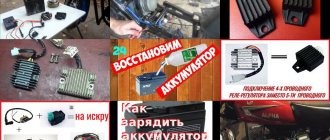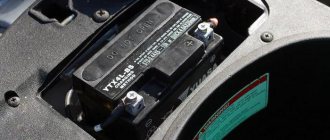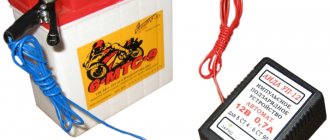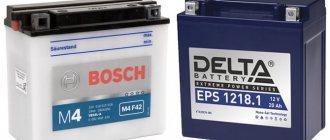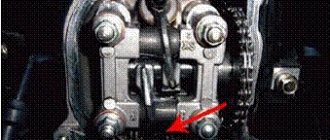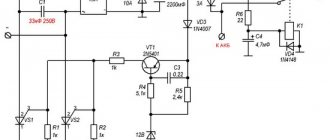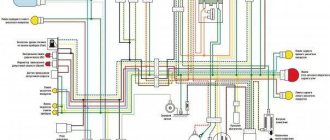Unlike car batteries, motorcycle batteries have a lower capacity. At the same time, they work better due to kickstarter. No matter how functional the battery is, it needs to be recharged. To charge a motorcycle battery, you do not need to have special knowledge; it is enough to control the voltage and current during the process. If this is not done, the battery will be overcharged, which will negatively affect its condition.
A motorcycle battery has a smaller capacity than a car battery.
Battery charging rules
It is important to remember that batteries of different quality require different charging frequencies.
For example, lead-acid batteries - once every month and a half or a month. Gel ones hold a charge longer, so it’s enough to charge them once or twice during the entire season. Before removal, it is important to write down the terminal connection diagram. This will save a lot of time when you reinstall the battery. Next, you need to wait until the battery warms up to room temperature. The charging itself should be carried out away from sources of fire or sparks. When connecting, observe the polarity.
There is a rule that works effectively for lead batteries: the current should be equal to 10% of the battery capacity. The desired value can be set on the corresponding regulator.
Often beginners do not know how long to charge a moped battery. It can be visually determined by the bubbles that begin to appear on the surface of the electrolyte. After this, the current is reduced by half and the battery is charged for about 2 hours.
Sometimes there are disputes about how to properly charge a dry-charged motorcycle battery. The standard duration of the procedure is up to 9-10 hours. If the battery is new, then 3-4 hours will be enough.
Gel batteries are also charged at a current of no more than 10% of the battery capacity. Even when charging a gel battery, there is no reduction in current for recharging.
When preparing to charge, avoid silly mistakes like incorrectly connected poles. Sometimes the battery becomes overcharged. In such a situation, use a current strength that is two times lower than usual - 5% of the battery capacity.
What do you need to know about battery charge/discharge?
If the voltage on the battery is not lower than 12.5 Volts, it’s okay, but you need to charge it as quickly as possible, otherwise sulfation will develop. Another important thing is that deep discharges shorten the battery life. But if the voltage on the battery is below 12.5 Volts, which indicates an unacceptably deep discharge, then the battery will indeed soon fail, since irreversible processes have begun.
Let's start charging the battery
So, the battery is ready to charge. Connect the terminals of the charger to the battery. The red terminal is to the positive terminal of the battery, the black (or blue) terminal is to the negative terminal. Don't mix up the polarity!
Most modern chargers automatically set the charge current and charging time. But if it is possible to set the charging current, it is chosen by dividing the nominal capacity of the battery by ten. For example, with a capacity of 4 Ampere-hours, the charge current should be 0.4A. In this case, the charging time will be approximately 10 hours.
You should not charge a motorcycle battery with a car charger if it cannot charge with a current of less than 1A. High charging currents can damage the battery.
The process of charging the battery of an Alpha moped is shown in this video
Noise when charging battery?
While charging the battery, the electrolyte enters into a chemical reaction with the lead plates, and its constituent acid releases gas (hydrogen) in the form of bubbles. Those. what you hear is the process of slight gas formation in the battery. Visually it looks like boiling.
Tips for proper charging
Make sure the battery is at room temperature before charging. It's also worth checking to see if there are any open flames or sparks nearby. After this, you can connect the charger, observing the polarity.
Lead-acid batteries must be charged at a current equal to 10% of their capacity. Therefore, using the current regulator, set the required value. In this form, charging should be carried out until the voltage reaches a value equal to the number of battery cells multiplied by 2.4 (for a standard battery, respectively, 14.4).
When visually observing the electrolyte, this moment will come when gas bubbles begin to form on the surface of the acid. After this, you need to reduce the current by half and charge for another 2 hours.
The gel battery is charged in a similar way. Here you also need to use a current that does not exceed 10% of the battery capacity. The main feature of this process is that the voltage supplied to it should not exceed the threshold. For most gel batteries, this indicator is in the range of 14.2-14.4 V. Well, the second stage of charging with a decrease in current is not required here. Just continue the process until fully charged. This usually takes about 10 hours.
And one more useful tip. If you have over-discharged your battery (it doesn’t matter whether it’s lead or gel), you need to revive it with a current half as strong as usual. That is, approximately 5% of its capacity. The charging time will also increase noticeably. If this doesn't help, nothing will help.
Types of Lithium Ion Batteries
There is some confusion with the term "lithium-ion" - it describes the technology rather than the specific chemistry of the battery. To make matters worse, different lithium-ion batteries have different cell voltages, but this information can help you understand what type of battery is used in a particular device (including a motorcycle).
All lithium-ion cells are divided into two groups. The nominal voltage in the first is 3.2-3.3 volts, and in the second - 3.6-3.7 volts.
Motorcycle batteries built on lithium ferrophosphate (LiFePO4) technology, also known as iron phosphate or nanophosphate, consist of four cells with a nominal value of 3.2 volts, giving a total of 12.8 volts and charging up to 14.4 volts (maximum - 14.6 volts).
Some manufacturers, for marketing reasons, state that their batteries have a nominal cell voltage of 3.3 volts (and together they then give 13.2 volts), but the LFP or LiFe marking will tell an understanding person that this is still the same 12.8- volt LiFePO4.
There are other lithium-ion battery chemistries, such as lithium cobalt oxide, lithium manganese, or even a combination of the two known as lithium polymer (the cells in these batteries are soft and can be molded into different shapes in the factory), but they all have a nominal cell voltage equal to 3.6-3.7 volts. Nowadays, 3.6-volt cells are almost never found, but high-voltage lithium-polymer cells with a nominal value of 3.85 volts can be found. Cells with a voltage of 3.7 volts should be charged with a voltage no higher than 4.2 volts, and at 3.85 V - no higher than 4.35 V.
However, these are not used in motorcycles. Mainly because three of these cells provide 11.1 volts (such a battery can be charged up to 12.6 volts, higher is dangerous), and four - 14.8 volts, which is outside the permissible voltage range for standard 12-volt motorcycle electrics . However, three- and four-cell batteries are used in jump starters, and three-cell batteries have a protective board built into the positive wire that prevents the flow of current from the on-board network to the jump starter to avoid overcharging and overheating.
No lithium-ion technology can withstand overcharging and can ignite if overheated.
How to charge a gel battery for a moped without special charging
A couple of years after purchasing a moped, it becomes necessary to recharge the battery. And then it turns out that the battery belongs to the category of gel batteries, for which not all chargers are suitable. How to restore battery capacity if a special charger is not at hand?
Is there an alternative to special memory devices? The gel battery does not tolerate overdischarge, as a result of which the gel melts and turns into liquid. For this reason, devices capable of charging a lead or AKB battery for a moped are not suitable for recharging. These options have too high current and voltage ratings.
You need special chargers with automatic adjustment of the charging current, which are quite difficult to find on sale. The voltage of a suitable charger does not exceed 14 V, and the upper current threshold corresponds to 1/10 of the battery capacity (for 5 Ah - 0.5 A, for 7 Ah - 0.7 A). In this case, the device determines the charging time and turns off automatically when the battery is fully charged.
As an alternative to special chargers, you can use conventional chargers with a low charge current (for example, 0.5 A) and an output voltage of 12 V, which are suitable for recharging batteries with a capacity of 5 Ah or more. In this case, it is important to turn off charging in time to prevent the battery from heating up.
To determine the duration of the procedure, it is worth dividing the battery capacity by the current strength (for a 5 Ah battery and a 0.5 A charger, the charging time will be 10 hours). It is also important to periodically check the voltage on the gel battery using a tester: it should not exceed 14 V.
Which factors shorten and which extend battery life?
The following factors can reduce battery life:
- Frequent full discharges and charges. The first sign of element failure is a light coating.
- Overheat. If the case temperature reaches 50°C, the likelihood of failure increases.
- Operation in frosty weather.
- Long-term storage in a discharged state. When the voltage drops to 10 V, the battery can be disposed of.
The service life is extended by reducing the output voltage to 0.3 A. The charging duration increases to 24 hours, but the loss of capacity is reduced.
Types of chargers
To restore the charge of moped batteries, the following types of devices are used:
- Simple. The required characteristics of the electricity supplied by the devices are specified by the user. It is necessary to constantly monitor the condition of the product using a universal tester. If a multimeter is not available, remove the plugs and measure the density of the acid solution. Other characteristics of a simple charger are not much different from the properties of more expensive models.
- Automatic. In this case, the device independently controls the process, choosing the appropriate parameters. Automatic devices are well suited for restoring the power of motorcycle batteries at home.
- Automotive. They are rarely used, which is explained by the difference in battery capacities for cars and motorcycles. An automobile charger produces high current, which leads to boiling of the electrolyte and destruction of the plates. Batteries charged with such devices often become unusable. Car chargers can be used if they have a parameter adjustment function.
Types of batteries for bikes
The answer to the question “ which battery to choose for a motorcycle ” depends on the technical parameters and configuration that the manufacturer determined for each model:
- Lead-acid batteries are used in older models of motorcycles; they are cheap and sold in most specialty stores. The operation of this unit is ensured by liquid electrolyte, the level of which must be constantly checked and, if necessary, topped up, since it tends to evaporate;
- AGM power supplies are suitable for modern models of equipment with advanced electronics. Their structural design consists of positive and negative plates, with fiberglass mats between them. The plates themselves are filled with electrolyte, the advantages of this type are shock resistance and high starting current;
- gel devices. The electrolyte of this type of power supply has silica added, which makes its consistency more dense. Such devices are resistant to full discharges, can operate at a higher load than AGM, they are used for lightweight equipment that requires a lot of energy to operate the electronics;
- Lithium-ion drives are the lightest and most expensive option; they are 80% lighter than lead-acid types, they do not contain acid, and can be installed at a strong angle. Such batteries last a long time, have a low level of self-discharge, and charge quickly.
Why do you need to maintain electrolyte levels?
Maintenance-free or low-maintenance lead-acid batteries use an electrolyte that is a solution of sulfuric acid and distilled water. During operation, water evaporates and the concentration of sulfuric acid increases. Concentrated acid can cause accelerated corrosion of the internal elements of the battery, which leads to the formation of sediment, which can subsequently lead to short-circuiting of the oppositely polarized plates.
What to do if the electrolyte level in the battery has dropped?
You need to purchase distilled water and add it to the battery. The electrolyte is dilute sulfuric acid. During the operation of the battery, only a slight evaporation of water occurs, which needs to be topped up. Under no circumstances should you add new electrolyte, only distilled water!
How to check electrolyte level
There are lines on the wall of the battery that indicate the maximum and minimum level in each bank. Take the battery carefully in your hands and hold it up to the light. This way you can see how much electrolyte is in each jar. It should be between the minimum and maximum lines.
Pros of lithium-ion batteries
The fact is that they lack one of the main disadvantages of lead-acid. The capacity of lead-acid batteries seems quite large, for example 10 amp hours implies that this battery can hold a load of 10 amps for an hour, or 20 amps continuously for half an hour, or 40 amps for 15 minutes at a time. Yes, but not so. 40 amperes is a current quite sufficient to turn over a medium-sized motorcycle engine, and 15 minutes of such work seems like a lot. But in fact, lead-acid batteries are not capable of delivering really high current at any state of charge.
That is, a half-empty lead-acid battery will no longer be able to produce 40 amperes, but the same 10 amperes will be sufficient. Therefore, formally its capacity is large, but its useful capacity (for the operation of the electric starter) is half, or even four times less.
Lithium-ion batteries are capable of delivering powerful currents up to the deepest discharge. Therefore, a 4-amp-hour lithium battery can start the engine more times than a 10-amp-hour lead battery. Plus, lithium batteries are lighter and more compact, even with comparable capacities. But they also have disadvantages, in particular the price.
Why does a new battery drain?
There can be several reasons for rapid battery discharge. Below we list the most common ones:
- The security alarm is faulty or the alarm has been on for a long time. Any current leakage reduces the battery charge.
- A faulty charge relay can result in the battery simply not being recharged from the generator during a trip. You can check the functionality of this device by turning on the headlight and increasing the engine speed - the brightness should increase. If the brightness decreases, your regulator most likely needs to be replaced.
- Faulty generator. To check its performance, it is enough to measure the voltage on the battery; with the relay-regulator and generator running, it should be at least 13.8 Volts, at 2-3 thousand rpm and the headlights are on low beam.
How often should you charge your motorcycle battery?
The battery must be charged each time it is completely discharged. Conventional acid (in common parlance, lead) batteries, if they are not worn out, require recharging on average after 45-60 days; Old ones need to be recharged more often. But gel motorcycle batteries are more viable - 1-2 recharges per season will be enough for them.
Do not forget that the battery is characterized by a certain degree of self-discharge, even when turned off. This most often occurs in winter, when bikers park their motorcycles and batteries sit idle on racks.
It is hardly advisable to delay recharging until the time when the battery has stopped showing all signs of life during any attempts to start the motorcycle. This may ultimately result in over-discharging, which is highly undesirable and can greatly affect the health of the battery.
To eliminate undesirable consequences, it is necessary to monitor the condition of the device and regularly test it with a voltmeter.
A simple testing procedure involves the following steps: the indicator is set at 20 volts, the red probe goes to ( +) , the black probe goes to ( –) . We look at the readings (volts):
- 12.3 – position within normal limits, no recharging required;
- 11-12.2 – the battery needs to be charged;
- before 11 – critical condition, urgent recharging is needed, although it may not save the situation.
What is sulfation and what causes sulfation?
Sulfation is an electrochemical process that occurs in a battery during discharge. The discharge can be different, starter and long-term, with low current. In case of prolonged discharge with low current (current leakage during inactivity) or undercharging from the generator, the plates are coated with lead sulfate. This process is reversible, called desulfation (occurs during the charging process). There are a number of reasons leading to sulfation:
- Frequent or constant undercharging, battery operation in negative balance (gives out more than it receives).
- Long-term storage of the battery in an undercharged state. The voltage is below 12.5 Volts.
- Deep discharge. A discharge below 10.5 Volts is especially dangerous. Then sulfation becomes irreversible. The battery loses a lot of its capacity and cannot be charged.
Many people mistakenly believe that sulfation occurs during overcharging, overheating and high loads at low or high ambient temperatures. But that's not true. Under these conditions, the active mass of the plates floats into slurry and the gratings warp.
How to prevent sulfation?
First of all, you need to keep your motorcycle's electrical system in good working order. The battery must renew the charge lost when starting the motorcycle. If you do not plan to use the moped for a long time, you must disconnect the negative (-) terminal from the battery.
In case of irregular use of the moped, charge the battery with a special charger. Elimination of sulfation is possible by charging the battery for a long time with a low current. In the best case, sulfation can be dealt with by a charger that has a pulse current charging function. There is also irreversible sulfation, in which the battery cannot be charged. The case of such batteries usually has swelling and gets very hot when trying to charge.
If I disconnect the battery, will it discharge?
Disconnected from the electrical circuit, even in good condition, the battery will still lose charge, although this will happen much more slowly than when it is connected to the moped. This process is called self-discharge. And the older the battery, the faster the self-discharge occurs.
Precautions when working with batteries
Batteries constantly produce explosive hydrogen, especially while charging. To avoid the potential risk of fire when working near a battery, the following guidelines should be followed:
- Do not smoke near batteries.
- Keep sparks, short circuits, or other sources of ignition away from the battery.
- When disconnecting/connecting current-carrying cables, be sure to first turn off the consumers, turn off the ignition, and turn the key to the off position.
- Ensure proper ventilation of the battery charging area.
The charger must be turned off in the following cases:
- when connected to a battery;
- when disconnected from the battery.
The ground wire (-) must be disconnected from the battery first and connected last.
Is lithium safe?
Of course, these batteries are certified and tested under adequate conditions. The main thing is that their operation occurs in normal modes.
For example, overcharging a lithium-ion battery can cause it to catch fire, so if you're thinking of replacing your stock lead-acid battery with a lithium one, check to see if your motorcycle's electrical system is compatible with lithium. For example, if the voltage in it can exceed 14.6 volts, it’s better not to, since this is the upper safe limit for a lithium-ion motor battery. Once again, the worst thing that can happen to a lithium-ion battery is overcharging.
Such batteries have a much lower self-discharge than lead-acid ones, but in most modern motorcycles there is bound to be some leakage to power the ECU, immobilizer and the like, even when the key is removed from the ignition. This is not to mention the alarm system, which can use up the charge of even a full lead battery in a couple of days if it is noisy or windy outside, or the feedback signal is unstable, and so on. Here we come to another point: lithium motorcycle batteries do not tolerate deep discharge and also become dangerous. The third nuance is that it is highly advisable to purchase a special charger for such a battery.
How to restore the battery
First, you need to thoroughly rinse the damaged battery with distilled water several times and pour the prepared electrolyte into it. We check the density of the electrolyte - normally it should be 1.27 g/cm³. Now you need to charge the battery for 10-12 hours.
After charging, connect any high-power power source to it and discharge it completely. We repeat the process at least ten, maximum fifteen times. This is exactly how it is recommended to “bring to life” an old acid battery. It is important to remember that you cannot leave it completely discharged for a long time between charge and discharge cycles.
Owners of mopeds, who thus save on buying new batteries, claim that after the battery has been restored, it can work for about a month and holds a stable charge. In some cases this can be quite useful.
Restoring a gel battery is often a thankless task. Most likely, you will not achieve a positive result.
In order for your scooter or moped to last as long as possible, you should not constantly ride it without a battery. It is better to purchase a suitable power source and provide it with proper care from time to time, thereby saving both the vehicle and its battery. It never hurts to know how to start a moped in emergency situations, but in order to avoid unpleasant consequences, this should not be abused.
And of course, for those who are limited in financial resources, we can recommend purchasing an inexpensive liquid-acid battery: it will require care, but it is not as complicated as it might seem at first. In addition, it is much more realistic and easier to restore such a battery on occasion than an expensive gel battery, which places higher demands on its owner.
How does a LiFePO4 motorbattery work?
Each cell contains an anode made of carbon, a cathode made of lithium ferrophosphate, and between them is an electrolyte made of lithium perchloride. In a discharged state, all the lithium is in the cathode and electrolyte, and in a charged battery, lithium ions move to the carbon anode. It's porous, so lithium ions fill those pores, and the battery is charged when they're all filled.
When the battery discharges, lithium ions leave the anode and are directed to the cathode, simultaneously creating an electromotive force between them and transferring energy through the flow of electrons through the connected load. Looks simple? But there are nuances.
When discharging, you should not completely empty the carbon anode, and when charging, you should not direct more lithium ions to it than enters it, and it is also undesirable to dissolve the lithium cathode. During overdischarge, when a deficiency of lithium ions occurs in the carbon anode, it begins to collapse as the walls of its pores become brittle. When overcharging, two troubles occur at once: at the cathode, pores capable of emitting lithium ions close, and at the anode, excess ions collide with carbon and heat it, which can cause it to ignite.
Unlike lead-acid batteries, it is better to keep lithium-ion batteries undercharged (since a fully charged battery is vulnerable to overcharging), but it should not be allowed to overdischarge below 30% - 13 volts, in other words.
Is it possible to ride a moped without a battery?
Experienced owners of scooters and mopeds can start them in any way - from kickstarter to using the most ordinary drill. There are amateurs who even write about this on their forums: “I’ve been driving without a battery for a month now and don’t bother about it.”
However, the consequences of constantly driving without a battery can be very disastrous for a moped. First of all, this concerns lighting devices: the bulbs in the turn signals burn out, the headlights do not burn well, the backlight begins to act up.
Why does this happen? Let's find out the reason.
If the moped has a battery, it is regularly recharged from the generator. But when it is not there, the current generated by the generator begins to flow into all devices: it simply cannot evaporate or dissolve in the air. As the driving speed increases, the voltage begins to increase, and the entire lighting system of the moped can “fly” at any moment. And the lamps themselves, in the absence of a battery, work much worse, because they simply do not have enough energy. They can shine dimly, blink, or even burn out due to uneven distribution of energy.
Based on this, we can conclude: driving for a long time without a battery can lead to the failure of all lighting. And not only him. For example, in this situation the generator is also forced to work in increased mode, which leads to its breakdown. You should think carefully before constantly driving in this manner.
It is best to purchase a suitable battery for your scooter - despite the fact that for some lovers of “trouble-free” riding, caring for the battery seems cumbersome. However, it is precisely to such people that we owe the fact that we now have at least several ways to start a moped without a battery in an emergency.
Charger options for motorcycle batteries
For each type, you should choose native ones or those designed by the manufacturer for a specific charging model: automatic or non-automatic chargers. The second option is cheaper than the first, but the main advantage of the first is that the process does not require constant monitoring: once connected to the network, the device itself sets the desired current level and maintains it throughout the entire time. With a non-automatic option, it is necessary to constantly monitor the state of the electrolyte using a multimeter or visually by unscrewing the plugs.
Helpful information
To protect the terminals from oxidation and the appearance of a white coating, they need to be cleaned, securely fastened and only then lubricated with grease (technical Vaseline, Litol, Solidol, etc.) or protected with a special acid-resistant mastic. The battery being serviced must have a special tube for removing gases; it must be taken outside the motorcycle and not closed; it serves to remove gases and condensate during operation. You can insert the battery into a rubber or plastic box that is slightly higher than the battery. Then, if the electrolyte suddenly spills out, it will not get on the frame and other parts of the motorcycle.
Limitations of Li-ion Batteries
With a lot of advantages, lithium-ion batteries for a motorcycle are not an absolute blessing. Usually you need a good reason to replace lead with lithium: they have excellent starting current, but they really don't like to work in the cold, they are light and good for sports driving, but have either a small volume or a significant price tag. And they are also not at all suitable for motorcycles in which small consumers operate with the ignition off - for example, trackers or alarms. For tourism, when weight and volume do not impose critical restrictions, it is better to choose a high-quality AGM battery.
Main characteristics of rechargeable batteries
In order not to make a mistake when choosing a battery for a motorcycle, you need to understand the technical characteristics:
- Capacity
The parameter is measured in Ampere-hours (Ah) and indicates the ability of the unit to produce a certain power for 1 hour. If the label indicates 20 Ah, it means that the battery can produce a current of 20 A for an hour.
The larger the volume of the internal combustion engine of a motorcycle or ATV, the higher the capacity should be. Here you need to follow the recommendations of the manufacturer, who indicates the capacity for each specific model of equipment.
If the capacity is less than that recommended by the manufacturer, the engine may not start.
- Cold start current
The parameter indicates the battery’s ability to deliver the maximum current, the volume of which would be sufficient to start the electric starter at sub-zero temperatures. The current supply time is within half a minute.
In the labeling, this parameter is designated by the abbreviation SSA.
- Voltage
For motor vehicles, batteries with a voltage of 12 V are mainly installed. For small-capacity equipment (scooters, scooters), units with a voltage of 6 V are installed.
- Dimensions
The unit must fit the size of the site where it will be installed. If the dimensions match, the battery will be level. Therefore, it is necessary to find out in advance the value of this parameter, which is indicated in the operating instructions for the motorcycle and on the body of the old battery.
- Terminals and Polarity
To select the correct type of terminals, use the standard size specified by the manufacturer.
When selecting polarity, take into account the location of the positive and negative terminals. If the plus is located on the right - reverse, on the left - straight.
- Frame
In the production of cases, impact-resistant plastic is mainly used. The main requirement for the housing is tightness. The equipment must be protected from mechanical influences, vibrations, and overturning.
Read also:
- Rules for charging smartphones are listed
- Just not at night: experts tell us how to properly charge your smartphone
- A unified standard for wireless charging for electric vehicles is already being tested
Named 4 mandatory steps when buying a battery- Harley-Davidson has abandoned electric motorcycles
- We invite lovers of technology and outdoor activities to the exhibition “MOTOSPRING 2021”
Tags:: Rdrive StartEasy, motorcycle battery, charging AGM batteries, charging a motorcycle battery, charger for AGM batteries
Examples of motorcycle battery models from various manufacturers
Exide
A well-known manufacturer has in its product line “Bike” batteries for motorcycles, scooters and other motorcycle equipment:
- Standard WET (6 and 12 volts);
- Maintenance free AGM (12V);
- Sealed GEL (12 V).
Banner
This Austrian manufacturer has in its arsenal the Bike Bull series, which includes classic lead-acid batteries, as well as Bike Bull AGM and GEL, which are recommended for motorcycle equipment operating in difficult conditions.
- Bike Bull WET. 6 V, 4 Ah;
- Bike Bull AGM. 12 V, 3 Ah;
- Bike Bull AGM PROfessional. 12V, 8 Ah;
- Bike Bull GEL. 12V, 3 Ah.
Varta
Varta offers a line of Powersports batteries for motorcycles and scooters. There are about 60 different models.
- Powersports Freshpack. Dry-charged batteries supplied with electrolyte;
- Powersports AGM. Maintenance-free batteries;
- Powersports GEL. Varta recommend using them in various tourist equipment;
- Powersports Gardening. Designed for garden equipment such as lawn mowers.
Bosch
This manufacturer's line also includes a category of motorcycle batteries. It includes:
- Bosch M4 Fresh Pack. The battery is sold dry-charged with electrolyte for filling;
- Bosch M6 AGM. Bosch notes the tightness and vibration resistance of AGM models;
- Bosch M6 Gel. M6 Gel motorcycle batteries are recommended for use on motorcycle equipment operating in difficult conditions.
This is only a small part of the batteries that are offered for motorcycles on the market. Almost all manufacturers of car batteries have their own solutions for motorcycles.
If there is no charge
To fix this problem, let’s first figure out how the battery is charged in general. While the engine is running (over 2 thousand revolutions), the generator is switched on, creating current (alternating current). To convert alternating current into direct current, a converter is provided in the scooter's electrical system. In this case, the stabilizer. The stabilizer also serves to prevent the scooter's battery from overcharging. If there is a problem in this system (generator-stabilizer-battery), the battery will not receive charging.
In order for charging to be constant, it is necessary to do the following:
- Check contacts and fuse. Clean the contacts and replace the fuse if broken.
- You should also pay attention to the battery terminals. They must be properly stripped and tightly attached.
- Inspect all plugs and connections (wires).
- Check for ground (wire connected to the equipment frame and battery negative.)
In most cases, the operations performed are enough to correct the problem in question. But there are other, more advanced cases. Let’s go even deeper and consider a number of actions that will certainly help.
When to charge the battery
Before charging the battery, you must ensure that it is truly discharged. There are several ways to do this:
- Measuring voltage at terminals . This can be done using a constant voltage voltmeter, in other words, an electronic multimeter or a pointer tester. For standard batteries used in most passenger cars, the standard voltage value is 12 V. In practice, it differs slightly from the nominal value. So, a value equal to 12.7 V tells the car owner that the battery charge level is 100%, and accordingly, there is no need to charge it. If the measured voltage is 12.2 V, then this indicates that the charge level is approximately 50%. And if the voltage drops to 11.6...11.7 V, it means that the battery is almost completely discharged and it needs additional charging.
- Measuring the electrolyte density value . However, this verification method is only possible for so-called serviceable batteries, that is, in which it is possible to reach containers with electrolyte (and add it, if necessary). To measure density, a special device is used - a hydrometer. The electrolyte density should be around 1.27 g/cm³. If it is significantly less, it means that the battery should be charged with a charger. In unattended ones there is a special window where 3 stages of density will be displayed.
- Problems starting the engine . One of the reasons why the starter does not turn, and problems arise with starting the engine, is precisely the battery discharge. This is usually accompanied by problems in the operation of other consumers of electricity in the car - lighting, operation of the audio system, and so on.
In a discharged battery, sulfation of its lead plates occurs, which leads to a sharp decrease in its service life, that is, durability.
How to maintain the battery?
To extend the life of the battery, high-quality and timely maintenance is required:
- It is recommended to check the operation of the electrical circuit before traveling. Short circuits and other emergency situations lead to increased load on the battery. The higher the load, the faster the sulfation process will start.
- It is necessary to ensure the cleanliness and tightness of the battery. If metal shavings or dirt gets into the electrolyte, a rapid discharge occurs. In such cases, recharging will be required every 2-3 days. If a crack or chip is found on the case, the battery must be replaced with a new one. Such damage leads to electrolyte leakage. In GEL batteries, it is possible to replace the case.
- Deep discharge is the main danger to the battery. After the trip, you must turn off the power plant. You should also carry out regular checks of the motorcycle's electrical system and the voltage at the terminals. When using acid batteries with liquid electrolyte, it is necessary to monitor its level.
- If the simplest acid battery is installed, experienced users recommend flushing the housing once a year. To do this, pour out the electrolyte and pour in the distillate, and clean the dirt.
- To clean the terminals from oxide, use regular sandpaper. It not only relieves oxidation, but also helps improve contact.
- It is also necessary to purchase a multimeter that will allow you to measure voltages and determine current leakage.
Particular attention is paid to storing batteries. The Russian climate does not allow year-round use of motor vehicles. Therefore, at the end of the season, motorcycle owners put the equipment in the garage after removing the battery. To store the battery correctly, adhere to the following algorithm:
- Before “preservation,” the battery is recharged and left in a dry place. Storage temperature should be room temperature. In cold weather, the electrolyte will freeze, which will lead to a discharge.
- The terminals are cleaned of oxide.
- The housing should not be exposed to water or dirt.
- Before the start of the season, exercises are carried out.
Important.
The battery should not remain discharged for a long time.
At low storage temperatures, the unit is discharged by more than 1% per day. The problem can be solved by connecting an automatic charger or periodic manual charging.
